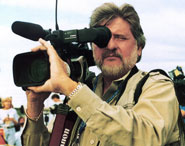 |
→ November 2004 Contents → Welcome
|
Welcome to the November issue of the Digital Journalist, the online monthly magazine for Visual Journalism. Photojournalism is an all-encompassing field. It can be as prosaic as a small newspaper photographer covering the events of the community, up to big magazines and books. It can evolve into documentary photography, in which a point of view becomes a thesis, or even further, into anthropology. National Geographic photographer Chris Rainier takes us into the latter world with his cover feature this month, "Ancient Marks," as he looks at how tattoos have defined cultures. Ten years ago, South Africa emerged from apartheid. Peter Bendheim, an Afrikaner, looks at what the transition has meant. Digital Journalist Editor for Europe, Horst Faas, has been pounding the floors at the biggest photo show in the world, Photokina, and contributes the first of a two-part report on how the industry is changing from film to digital. Bill Snead was there when the legendary photographer for Life magazine, Gordon Parks, returned to his hometown in Kansas. Talking about Life, our Executive Editor, Peter Howe, who was, in fact, a Life picture editor, takes a critical look at the magazine's newest incarnation as a newspaper supplement. It is clear that the World Wide Web has created a whole new breed of journalists. Blog writers were welcomed and accredited to the national conventions this year, a reflection of their growing impact in journalism. This is no surprise to us; from the beginning, we have understood that the most undervalued people in the journalism business were photographers. We take pride that we have encouraged them to find their voices, and write about their experiences, both in our Dispatches section and the Assignment Sheet. Dispatches is really intended to give photographers covering national and international events a place to talk about what it is like to be on the front lines of these events. The Assignment Sheet is for the majority of photojournalists, from both still and video, to talk about their day-to-day assignments for all those publications that make up the vast majority of photojournalism. Now we have added, thanks to Roger Richards, who runs our Digital Vision Network, our portal site, a blog area - http://dvnetwork.net/blog/ - that will extend this invitation to our readers even further. We encourage you to go there and tell us your stories. Of course, our Dispatches Editor, Amy Marash, will be monitoring these blogs, as will Assignment Sheet Editor Dick Kraus, for stories to be brought into our main sections. This month we are proud to announce a new partner to our Digital Vision Network, http://www.photoworkshop.com/. This multimedia site, created by photographer Robert Farber, is a wonderful companion for The Digital Journalist readers, and offers a deep site that is a resource for photography. In months ahead, you will see joint features co-produced by us and Photo Workshop. We are also announcing the spring 2005 Platypus Workshop, to be held at Brooks Institute in Ventura Ca. Since 1999, we have trained more than 200 still photojournalist in the language of television news. Graduates have gone on to producing documentaries for television, such as ABC Nightline, and creating original film content for their newspaper web sites. This year we are emphasizing a team approach, and recommending that publications send both photographers and editors to the school in order to maximize the effectiveness of these teams in the newsroom. You can apply on line, and we look forward to seeing you in California. This month's Assignment Sheet is the final chapter of the "D-Day Revisited" story by Dick Kraus, retired staff photographer from Newsday (Long Island, N.Y.). In his Epilogue, Kraus writes, "This story began for me in 1944 when, as a 12-year-old child, I listened to the radio reports of the invasion. I grew up with books and movies depicting the events of that day. "To be chosen to go to Normandy to document that struggle and to photograph so many of the brave men and women who participated in that epic event was indeed a great honor for me. "I consider this to have been the greatest assignment of my career. Thank you for taking the time to share the occasion with me." In Dispatches: This month, America: politics, baseball, and Mom. Three exhausted still photographers went the extra mile after logging tens of thousands of miles with the candidates, to write dispatches from deep inside Campaign 2004. Brooks Kraft and David Burnett went down to the wire with President Bush and Senator Kerry while David Hume Kennerly toughed out the backstretch with Vice President Cheney. Ezra Shaw, of Getty Images, sent his favorite photo of the incredible victory of the Boston Red Sox. Second to almost no one, the photo staff of the Boston Herald sent us their pix. "Being the feisty number 2 paper in Boston keeps us on our toes and very competitive," said photo editor Jim Mahoney. The resulting gallery is called BOSOX.JPG "Salad Bar " was the nickname of Cpl. William I. Salazar, the first Marine photographer to die in combat since the Vietnam War. AP photographer Damien Dovarganes snapped a gut-wrenching photo of Salazar's mother on the West Coast the same month Magnum photographer Paul Fusco captured the "Bitter Fruit" of a Gold Star Mother on the East Coast. The two photos of Moms burying their soldier sons close our Dispatch section with what is probably a preview of many more to come. Our regular columnists, Bill Pierce, Ron Steinman, Mark Loundy, Jim Colburn and Terry Heaton all have weighed in for this issue, which we hope you will enjoy. Dirck Halstead
|
